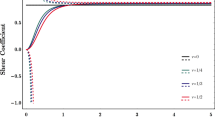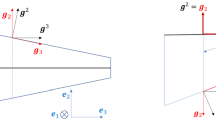Abstract
In many engineering applications it is often necessary to determine the flow of shear stresses in the cross-sections of beamlike bodies. Taking a cue from Jourawski's well-known formula, several scholars have proposed expressions for evaluating the shear stresses in non-prismatic linear elastic beams, where longitudinal variations in the size and shape of the cross-sections produces complex stress fields. In the present paper, a new shear formula, derived using a mechanical model developed in a previous work, is presented for tapered beams subject to even large displacements and small strains. Numerical examples and comparisons with results obtained using other formulas in the literature and non-linear 3D-FEM simulations show how the new formula constitutes an important generalization of the previous ones and is able to provide particularly accurate results.














Similar content being viewed by others
References
Navier CLMH (1864) Résumé des leçons données à l’école des ponts et chaussées sur l’application de la mécanique a l’établissement des constructions et des machines, 3me éd. avec des notes étendues par M Barré de Saint-Venant, Dunod, Paris
Love AEH (1944) A treatise on the mathematical theory of elasticity, 4th edn. Dover, New York
Sokolnikoff IS (1946) Mathematical theory of elasticity, 1st edn. McGraw-Hill, New York
Timoshenko SP, Goodier JN (1951) Theory of elasticity, 2nd edn. McGraw-Hill, New York
Jourawski DI (1856) Sur la résistance d’un corps prismatique et d’une piéce composée en bois ou on tôle de fer à une force perpendiculaire à leur longeur. Annales Des Ponts Et Chaussées 12:328–351
Balduzzi G, Hochreiner G, Fussl J (2017) Stress recovery from one dimensional models for tapered bi-symmetric thin-walled I beams: deficiencies in modern engineering tools. Thin-Walled Structures 119:934–945
Timoshenko SP, Gere JM (1984) Mechanics of materials, 2nd edn. Brooks/Cole Engineering Division, Brooks
Migliaccio G, Ruta G (2021) The influence of an initial twisting on tapered beams undergoing large displacements. Meccanica 56(7):1831–1845
Slocum SE (1911) A general formula for the shearing deflection of arbitrary cross-section, either variable or constant. J Franklin Inst 171(4):365–389
Bleich F (1932) Stahlhochbauten, vol 1. Springer, Berlin
Pugsley AG, Weatherhead RA (1942) The shear stresses in tapered beams. Aeronaut J 46:218–226
Saksena GB (1944) Shear stress in a tapering beam. Aircr Eng Aerosp Technol 16(2):47–50
Krahula JL (1975) Shear formula for beams of variable cross section. AIAA J 13(10):1390–1391
Russo EP, Garic G (1992) Shear-stress distribution in symmetrically tapered cantilever beam. J Struct Eng 118(11):3243–3249
Cortinez VH (1994) Shear-stress distribution in symmetrically tapered cantilever beam. ASCE J Struct Eng 120(2):676–678
Taglialegne L (2018) Analytical study of stress fields in wind turbines. PhD thesis, Unviersity of Florence
Bertolini P, Eder MA et al (2019) Stresses in constant tapered beams with thin-walled rectangular and circular cross sections. Thin-Walled Struct 137:527–540
Balduzzi G, Aminbaghai M et al (2016) Non-prismatic beams: a simple and effective Timoshenko-like model. Int J Solid Struct 90:236–250
Hodges DH, Ho JC, Yu W (2008) The effect of taper on section constants for in-plane deformation of an istotropic strip. J Mech Mater Struct 3:425–440
Hodges DH, Rajagopal A et al (2010) Stress and strain recovery for the in-plane deformation of an isotropic tapered strip-beam. J Mech Mater Struct 5:963–975
Berdichevsky VL (2009) Variational principles of continuum mechanics. Interaction of mechanics and mathematics. Springer, Berlin
Zappino E, Viglietti A, Carrera E (2018) Analysis of tapered composite structures using a refined beam theory. Compos Struct 183:42–52
Shin D, Choi S et al (2016) Finite element beam analysis of tapered thin-walled box beams. Thin-Walled Struct 102:206–214
Li GQ, Li JJ (2002) A tapered Timoshenko-Euler beam element for analysis of steel portal frames. J Constr Steel Res 58:1531–1544
Nagel GM, Thambiratnam DP (2005) Computer simulation and energy absorption of tapered thin-walled rectangular tubes. Thin-Walled Struct 43:1225–1242
Paglietti A, Carta G (2007) La favola del taglio efficace nella teoria delle travi di altezza variabile. In: Proc. of AIMETA conference, Brescia, Italy
Paglietti A, Carta G (2009) Remarks on the current theory of shear strength of variable depth beams. Open Civil Eng J 3:28–33
Balduzzi G, Sacco E, et al (2017) Non-prismatic thin-walled beams: critical issues and effective modelling. Associazione Italiana Meccanica Teorica e Applicata (AIMETA), pp 301–308
Trahair NS, Ansourian P (2016) In-plane behaviour of web-tapered beams. Eng Struct 108:47–52
Orr JJ, Ibell TJ et al (2014) Shear behaviour of non-prismatic steel reinforced concrete beams. Eng Struct 71:48–59
Zhou M, Fu H, An L (2020) Distribution and properties of shear stress in elastic beams with variable cross section: theoretical analysis and finite element modelling. KSCE J Civ Eng 4:1–15
Singer FL (1962) Strength of materials, 2nd edn. Harper and Row, New York
Mercuri V, Balduzzi G et al (2020) Structural analysis of non-prismatic beams: critical issues, accurate stress recovery, and analytical definition of the finite element (FE) stiffness matrix. Eng Struct 213:110252
Migliaccio G (2021) Non-prismatic beamlike structures with 3D cross-sectional warping. In: Proceedings of the 14th World Congress in Computational Mechanics (WCCM) & ECCOMAS congress 2020, Paris, France, 11–15 Jan. 2021
Gurtin ME (1981) An introduction to continuum mechanics. Mathematics in science and engineering, 1st edn. Academic Press, Boston
Ruta G, Pignataro M, Rizzi N (2006) A direct one-dimensional beam model for the flexural-torsional buckling of thin-walled beams. J Mech Mater Struct 1:1479–1496
Dell’Isola F, Bichara A (2005) Elementi di algebra tensoriale con applicazioni alla meccanica dei solidi, 1st edn. Società Editrice Esculapio, Bologna
Courant R, Hilbert D (1953) Methods of mathematical physics, 1st edn. Interscience Publisher, Hoboken
Madenci E, Guven I (2015) The finite element method and applications in engineering using Ansys, 2nd edn. Springer, Berlin
Migliaccio G, Ruta G et al (2020) Beam-like models for the analyses of curved, twisted and tapered horizontal-axis wind turbine (HAWT) blades undergoing large displacements. Wind Energy Sci 5:685–698. https://doi.org/10.5194/wes-5-685-2020
Migliaccio G, Ruta G (2020) Rotor blades as curved, twisted, and tapered beam-like structures subjected to large deflections. Eng Struct 222:111089
Author information
Authors and Affiliations
Corresponding author
Ethics declarations
Conflict of interest
The authors declare that they have no conflict of interest.
Additional information
Publisher's Note
Springer Nature remains neutral with regard to jurisdictional claims in published maps and institutional affiliations.
Appendix
Appendix
In the case of rectangular cross-sections, Eqs. (34)–(39) generalize the Jourawski’s solution for prismatic beams [5]. It is worth noting that if the current and reference states of the beam are very close and can be thought to almost coincide, such equations reduce to the formulas made available in the literature by other investigators who have studied the effects produced by the taper (e.g., Refs. [10, 15, 16]). To prove this, it is sufficient to specialize (37) for a flap-wise linearly tapered beam, loaded at the tip by an axial force N, transverse force T, and bending moment M, undergoing small displacements of the centre-line and small rotations of the local triads. Starting with (37), with θ≃0, we obtain:
The next step is to express coefficient Λ3 as a linear function of s:
where h3R is the height of the cross-section at the root (i.e., at s = 0), and angle α denotes the slope of the beam extrados. Combining (46)–(47) yields
The expressions for the cross-sectional area A and moment of inertia J3 for the present case are to be substituted into (48), as are those for the cross-section resultants FX, FZ, MY with those in terms of axial force N, transverse force T, and bending moment M applied at the tip section, i.e. FX = N, FZ = T, MY = M-T(L − s), where L is the beam length. We finally obtain
which is the expression we can find, for example, in [16].
A similar relation can be obtained for elliptical cross-sections. As an example, still assuming small displacements, when one dimension, say h2, is kept constant and a linear taper is assumed for the other, h3, starting with (43), we get
Similar expressions can be obtained for other tapered beams, characterized by solid or hollow cross-sections of various shapes, and will be presented in subsequent works.
Rights and permissions
About this article
Cite this article
Migliaccio, G., Ruta, G., Barsotti, R. et al. A new shear formula for tapered beamlike solids undergoing large displacements. Meccanica 57, 1713–1734 (2022). https://doi.org/10.1007/s11012-022-01529-1
Received:
Accepted:
Published:
Issue Date:
DOI: https://doi.org/10.1007/s11012-022-01529-1




